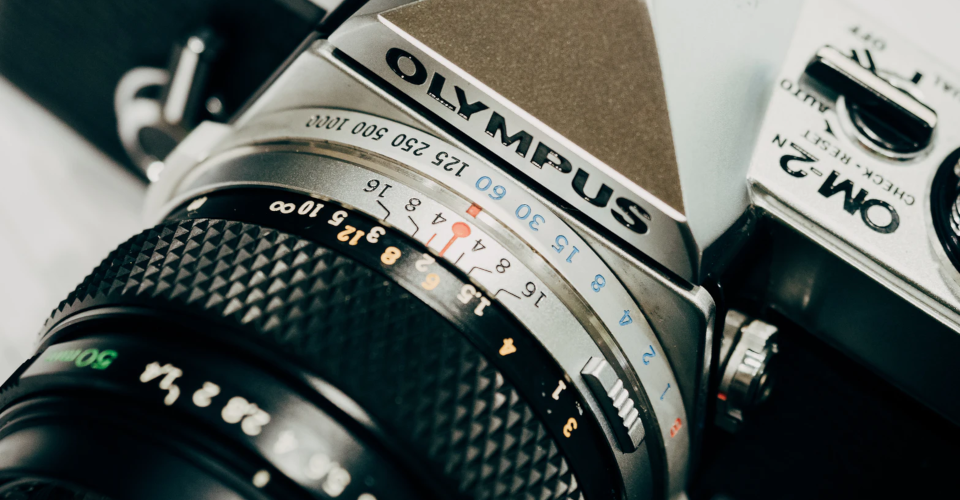6 Best Olympus Prime Lenses in 2020
Micro Four Thirds or MFT cameras made by Olympus are a popular choice for professionals and enthusiasts alike. They’re smaller and less cumbersome than full-frame or APS-C cameras yet can produce images of exceptional quality. They’re less expensive and come with benefits other manufacturers don’t offer, like excellent in-body image stabilization on all models.
This time we’re taking a look at the six best Olympus prime lenses on the market. They have fixed apertures, which makes images taken with one that much more detailed. Primes are nothing if not versatile, and we’ve covered a significant part of the focal length spectrum photographers use daily. See what Olympus has to offer and treat your MFT camera to a new, dependable lens.
Note: MFT lens focal lengths correspond to twice their length in 35mm terms. A 45mm Olympus lens is equivalent to a 90mm full-frame lens by other manufacturers. Olympus and Panasonic developed the MFT platform jointly, so their lenses are interchangeable.
| Budget |
|---|
 |
| Olympus M.Zuiko Digital 25mm F1.8 |
| 4.3/5.0 |
| Type: Standard prime |
| Focal length: 25mm |
| Has balanced optical properties. |
| Check Amazon |
| Best Value |
|---|
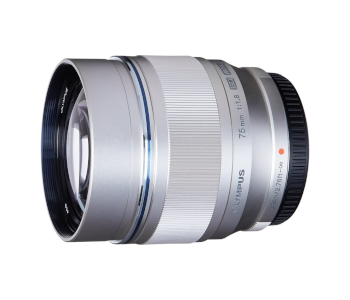 |
| Olympus M.Zuiko Digital ED 75mm F1.8 |
| 4.6/5.0 |
| Type: Telephoto prime |
| Focal length: 75mm |
| This has a silent and accurate autofocus. |
| Check Amazon |
| Top Pick |
|---|
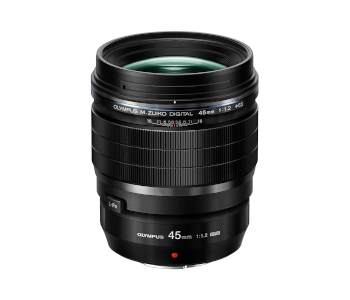 |
| Olympus M.Zuiko Digital ED 45 mm F1.2 PRO |
| 4.9/5.0 |
| Type: Portrait prime |
| Focal length: 60mm |
| No flares or ghosting and beautiful bokeh. |
| Check Amazon |
Olympus Prime Lenses Comparison Table
| Image | Product | Overall Rating | Image quality | Build quality | Versatility | Price |
|---|---|---|---|---|---|---|
 | Olympus M.Zuiko Digital ED 45 mm F1.2 PRO | 4.9 | 5.0 | 4.9 | 4.7 | Check Price |
 | Olympus M.Zuiko Digital ED 75mm F1.8 | 4.6 | 4.6 | 4.5 | 4.8 | Check Price |
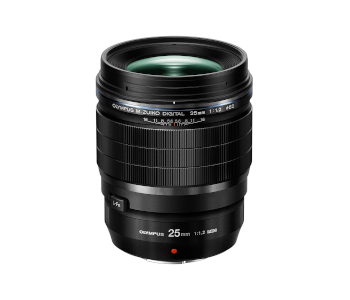 | Olympus M.Zuiko Digital ED 25mm F1.2 PRO | 4.7 | 4.7 | 4.8 | 4.7 | Check Price |
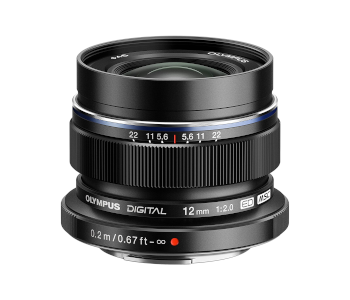 | Olympus M.Zuiko Digital ED 12mm F2.0 | 4.5 | 4.5 | 4.4 | 4.6 | Check Price |
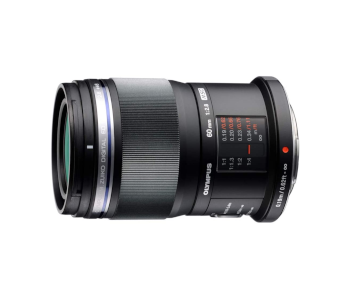 | Olympus M.Zuiko Digital ED 60mm f/2.8 Macro | 4.4 | 4.6 | 4.4 | 4.3 | Check Price |
 | Olympus M.Zuiko Digital 25mm F1.8 | 4.3 | 4.2 | 4.3 | 4.5 | Check Price |
1. Best Overall – Olympus M.Zuiko Digital ED 45 mm F1.2 PRO
Editor’s Rating: 4.9/5
The 45 mm F1.2 PRO is the most versatile MFT lens Olympus has produced to date. Its focal length is ideal for portraits, but a lack of distortion and lightning-fast autofocus make it a suitable candidate for sports and architecture photography too. Add to that exceptional build quality & sharpness, and you’ve got a standout lens that any professional MFT photographer should have in her arsenal.
Overview of Features
We were delighted by the 45 mm F1.2 PRO’s appearance and physical characteristics. It’s just the right weight to feel substantial when focusing manually but not too heavy to bog your camera down. The lens is weather-sealed and protects the camera from dust ingress with its rubber gasket. It’s comprised of 14 elements in 10 groups, including one with extra-low dispersion. A reversible barrel-shaped hood is included, and the 62mm thread takes ND filters as well as polarizers.
A single L-Fn switch breaks up the 45 mm F1.2 PRO’s symmetry. Pressing it will briefly disable the autofocus by default. You can reconfigure it as a custom function button for ISO or other settings. The autofocus is among the best we’ve tested—silent, fast, and not prone to hunting even in challenging light. Manual focus is equally satisfying. You engage it by pulling the focus ring back, which also reveals a distance scale. The ring offers slight resistance and has hard stops at either end, making it perfect for executing precise adjustments.
The 45 mm F1.2 PRO’s sharpness is exemplary. It’s impressively even when wide open, a feat few f/1.2 lenses can accomplish. The resolution continues to rise uniformly before hitting its peak at f/4. It holds steady after that, only declining past f/11 due to diffraction. Even so, the lens remains more than usable throughout.
Other optical features continue the 45 mm F1.2 PRO’s outstanding trend. It has no distortion. None. You’ll likely never encounter ghosting and flares accidentally, as they’re particularly hard to induce. Chromatic aberration isn’t a problem and doesn’t show up unless you’re shooting contrasting subjects at f/1.2. Olympus describes the bokeh as “feathered.” We’re not sure what that kind of marketing speak is supposed to indicate, but the results are more than pleasing.
What We Didn’t Like
Coming up with negative things to say about the 45 mm F1.2 PRO was a struggle. It exhibits some vignetting, but that disappears by the time you step down to f/.2. The lens lacks image stabilization, so users of some Panasonic cameras that also omit it will need to carry a tripod.
| Tech Specs |
|---|
| Dimensions: 2.8 x 2.8 x 3.3” |
| Weight: 14.5 oz |
| Type: Portrait prime |
| Focal length: 60mm |
| Maximum aperture: f/1.2 |
| Minimum aperture: f/16 |
| Minimum focus distance: 1.6’ |
| Angle of view: 27° |
| Image stabilization: No |
| Pros |
|---|
| World-class sharpness and distortion control |
| Robust and weather-sealed |
| No flares or ghosting |
| Beautiful bokeh |
| Cons |
|---|
| Some vignetting when wide open |
| No image stabilization |
2. Best Value – Olympus M.Zuiko Digital ED 75mm F1.8
Editor’s Rating: 4.6/5
Telephoto primes for the MFT system are a rare sight, and the 75mm F1.8 is the perfect combination of outstanding optics at a reasonable price. It’s a fast lens that lets you capture close sports action or wildlife while also e excelling at urban and architecture shots. Its sharpness is off the charts, so don’t be surprised if it manages to capture slight details even much more expensive lenses couldn’t.
Overview of Features
The 75mm F1.8 is among the smallest and lightest telephoto lenses in existence, with a diameter of 2.5 and a length of just 2.7 inches. It’s beautifully crafted from metal, available either in matte black or tasteful silver. It’s treated with Olympus’s ZERO coating for reduced glare, has ten elements in nine groups, and nine rounded blades for dreamy bokeh at wide apertures.
The lens uses an MSC or Movie & Stills compatible autofocus motor that performs on par with our overall winner. It’s unaffected by low light and can keep pace with unpredictable subject movement. The focus ring is wide and comfortable to hold. It focuses by wire, driving the motor with exceptional precision.
The 75mm F1.8 boasts outstanding sharpness but differently than the portrait prime above. Its center is already commendably detailed at f/1.8, with everything but the extreme edges following closely. Stepping down improves central sharpness drastically, to the point that it set the record for the sharpest MFT lens at the time of release. The results are still impressive today and don’t let up until f/5.6. You may continue to use the lens at smaller apertures as diffraction never renders images unusable.
Pincushion distortion is academic at just 0.5 percent. ZERO coating does an excellent job of protecting the lens from image degradation caused by flares. Some loss of contrast is the worst you can expect without intentionally inducing artifacts. Background blur is smooth while bokeh balls are round until f/4 when the aperture blades first make a slight appearance. Chromatic aberration is kept under control and never exceeds one pixel.
What’s Bad About It?
The 75mm F1.8 lacks weather sealing, which is a shame given its focal length meshes well with outdoor environments. Olympus doesn’t include a lens hood with this lens. You can get it separately, but that will set you back another $50.
| Tech Specs |
|---|
| Dimensions: 2.5 x 2.5 x 2.7” |
| Weight: 10.8 oz |
| Type: Telephoto prime |
| Focal length: 75mm |
| Maximum aperture: f/1.8 |
| Minimum aperture: f/22 |
| Minimum focus distance: 2.7’ |
| Angle of view: 16° |
| Image stabilization: No |
| Pros |
|---|
| Excellent value for the money |
| Outstanding central sharpness |
| Silent and accurate autofocus |
| Excellent flare resistance |
| Cons |
|---|
| No weather sealing |
| Doesn’t come with lens hood |
3. Olympus M.Zuiko Digital ED 25mm F1.2 PRO
Editor’s Rating: 4.7/5
A focal length of 25mm for MFT cameras corresponds to the “nifty fifty” in full-frame terms, making the 25mm F1.2 PRO one of the most versatile lenses on our list. It has some of the best flare resistance we’ve ever encountered, is sharp from the get-go, and built to last. You’ll have to part with quite a lot of money to get it, but that’s the price of razor-thin focus on MFT systems.
Overview of Features
The first thing you’ll notice about the 25mm F1.2 PRO is its size. The lens is bulky and large thanks to an intricate glass array comprising 19 elements in 14 groups. These include everything from aspherical to extra dispersion elements along with the latest coatings for even better performance. Being part of the PRO line, this lens boasts excellent build quality and complete weather sealing. A large reversible hood is included and improves its already outstanding flare resistance.
The 25mm F1.2 PRO’s autofocus is slightly slower than that of its 45mm cousin. Even so, it locks onto stationary subjects with ease and precision regardless of the lighting. The lens has the same clutch focus design, allowing you to pull its focus ring back and make minute adjustments. It mimics the feel of traditional manual focus well, as there’s some resistance and hard stops at both ends.
Sharpness isn’t quite on the 45mm’s level, but it’s commendable. Portrait photographers can use any aperture they wish as the center is always well-defined. The corners take a while to catch up, reaching their peak from f/4 to f/8. Performance is still excellent at f/11 as only f/16 has pronounced diffraction issues.
As mentioned above, there’s no hint of flares or ghosting. Not even the contrast will drop if you shoot directly into the sun! There’s a minuscule amount of barrel distortion you can easily dismiss in real-world situations. Bokeh is wonderfully smooth, as are blurred parts of the image, however far your subject is from the camera. There’s some vignetting when shooting wide open. It goes away at f/1.8.
Are There Drawbacks?
The 25mm F1.2 PRO is the most expensive lens on review. It also has some issues with chromatic aberration, which can approach two pixel widths in the corners. This happens if you’re shooting contrasting scenes like branches during cloudy days. You can step the lens down or correct for the fault in-camera.
| Tech Specs |
|---|
| Dimensions: 2.8 x 2.8 x 3.4” |
| Weight: 14.5 oz |
| Type: Standard prime |
| Focal length: 25mm |
| Maximum aperture: f/1.2 |
| Minimum aperture: f/16 |
| Minimum focus distance: 11.8” |
| Angle of view: 47° |
| Image stabilization: No |
| Pros |
|---|
| World-class resistance to flares and ghosting |
| Excellent build quality |
| Commendably sharp |
| Precise clutch focus |
| Cons |
|---|
| Expensive |
| Some Chromatic aberration at f/1.2 |
4. Olympus M.Zuiko Digital ED 12mm F2.0
Editor’s Rating: 4.5/5
MFT owners interested in wide-angle photography needn’t look further than the 12mm F2.0 for all their landscape, indoor, or food photography needs. It’s a lens with impeccable flare resistance & distortion control, sharp as a tack, and compact to boot. We recommend the Olympus M.Zuiko Digital 17mm F1.8 if you don’t mind a slight increase in focal length accompanied by a much more accessible price.
Overview of Features
Every Olympus lens we’ve reviewed so far looks attractive, but this one takes the cake. It’s slim and light, yet no compromises were made to its build quality. The 12mm F2.0 combines an all-metal barrel & mount with 11 glass elements in 7 groups. It’s the first Olympus lens to feature ZERO coating and accepts polarizers since the filter thread doesn’t rotate during focus.
Speaking of which. The 12mm F2.0’s autofocus performance is exemplary. It has a short minimum focusing distance of fewer than eight inches, allowing you to take pictures of mouth-watering dishes while capturing some of their ambiance. Videographers will appreciate the nearly silent autofocus, while everyone will love the focus clutch system we’ve already described in detail elsewhere.
The 12mm F2.0’s sharpness performance is excellent yet predictable. You can look forward to even results at maximum aperture as the difference in resolution between center and periphery is negligible. Changing to f/2.8 improves overall sharpness slightly yet equally. The trend continues until performance peaks at f/5.6, after which it declines as slowly as it got better.
This is another lens you won’t mind shooting buildings with as barrel distortion is only 0.3%. It wasn’t designed with creamy bokeh in mind but doesn’t create onion rings or jagged edges either. You’ll see some fringing at max aperture in the corners; the center remains free from it. There are no significant problems with flares or artifacts, and vignetting is only noticeable at f/2.
What We Didn’t Like
The 12mm F2.0 is primarily a landscape photography lens, so it’s disappointing that it doesn’t have weather sealing. A lens hood isn’t included. You can buy one separately, but it’s expensive.
| Tech Specs |
|---|
| Dimensions: 2.2 x 2.2 x 1.7” |
| Weight: 4.6 oz |
| Type: Wide-angle prime |
| Focal length: 12mm |
| Maximum aperture: f/2.0 |
| Minimum aperture: f/22 |
| Minimum focus distance: 7.9” |
| Angle of view: 84° |
| Image stabilization: No |
| Pros |
|---|
| Quiet autofocus great for video |
| Light and compact |
| Uniform sharpness |
| Almost no distortion |
| Cons |
|---|
| Expensive lens hood sold separately |
| No weather sealing |
5. Olympus M.Zuiko Digital ED 60mm f/2.8 Macro
Editor’s Rating: 4.4/5
The 60mm f/2.8 Macro is the second macro lens to be released for the MFT system. It offers a great combination of construction quality, optical performance, and price we seldom see for lenses of this type. T’s capable of 1:1 magnification at its close focus distance, which is long enough to get shots of skittish bugs without frightening them.
Overview of Features
The 60mm f/2.8 Macro is among the svelte lenses in Olympus’s repertoire. It’s also light as the body is made from plastic, despite 13 elements in 10 groups. The lens balances well even on the smallest MFT cameras. It might feel less substantial than models with metal bodies, but it’s just as responsive and durable. It even has weather sealing.
Autofocus is the same MSC seen on other Olympus lenses, albeit with a greater degree of control. It’s snappy if given free rein and improves even more if you switch on the focus limiter. A prominent distance & ratio gauge is located behind the focus ring and makes lining up a shot correctly a breeze. Most photographers will want to focus manually in macro mode, which is why we’re glad that the ring is rubberized, broad, and precise during operation.
The 60mm f/2.8 Macro has an unusual sharpness curve. Expect outstanding central sharpness with softer corners when shooting wide-open. The center tops out at f/4. The edges & corners continue to improve until f/5.6, where images are at their clearest & most even. Resolution then worsens gradually and uniformly, becoming sub-par only at f/22.
Attention to flaring remains a reoccurring theme as the 60mm f/2.8 Macro is another lens that has little trouble with it. Bokeh is buttery smooth, but you might be able to make out some definition in the background. Next to no distortion is par for the course for macro lenses, and less than a stop of vignetting at f/2.8 is a welcome sight.
What’s Bad About It?
Olympus needs to rethink its lack of generosity when it comes to lens hoods. This is the third model on review whose hood you need to get separately. It’s a good one, too, sporting extra protection from harsh light and a novel mount that lets you slide it back when you need more light for close subjects. Chromatic aberration becomes noticeable as you step down and can exceed 1.5 pixels past f/11.
| Tech Specs |
|---|
| Dimensions: 2.2 x 2.2 x 3.2” |
| Weight: 6.5 oz |
| Type: Macro lens |
| Focal length: 60mm |
| Maximum aperture: f/2.8 |
| Minimum aperture: f/22 |
| Minimum focus distance: 7.5” |
| Angle of view: 20° |
| Image stabilization: No |
| Pros |
|---|
| Free from distortion and flaring issues |
| Small & lightweight yet built well |
| Quick autofocus augmented by a useful limiter |
| Creamy bokeh |
| Cons |
|---|
| Innovative lens hood sold separately |
| Visible CA at small apertures |
6. Best Budget Option – Olympus M.Zuiko Digital 25mm F1.8
Editor’s Rating: 4.3/5
Do you want to add a “nifty fifty” to your MFT arsenal but can’t justify paying the f/1.2’s price? Olympus had people like you in mind when releasing the 25mm F1.8. It’s not as bright as the more expensive model since it loses a full stop of light. You could get another lens with the money you’ll be saving, so it’s a reasonable sacrifice to make. Luckily, build quality, sharpness, and general optics remain strong.
Overview of Features
The differences between Olympus’s two 25mm lenses become apparent as soon as you look at them side by side. The 25mm F1.8 is much smaller and lighter than its brighter counterpart, mainly due to a plastic body and a reduction in glass complexity to just nine elements in seven groups. The lens comes with a deep circular hood. It’s not billed as being weather-sealed, but it does have a metal mount.
The differences in focusing capability are marginal when compared to the more expensive standard prime. The 25mm F1.8 performs adequately and is silent enough to be used for video production. A focus clutch is a feature reserved for more expensive cameras, but the focus ring is damped well and responds to input instantly.
The 25mm F1.8 is a well-rounded lens. Even so, sharpness is its best attribute. You can look forward to razor-sharp portraits at f/1.8 since the center is rich in detail. Moving towards f/2 sees picture quality improve evenly. The center starts to decline at f/4, while the corners continue to improve until f/5.6. The differences in sharpness are much less pronounced from that point onward.
An aperture of f/1.8 corresponds to f/3.6 on full-frame cameras, so the bokeh you get with the 25mm F1.8 is less uniform than you’d expect. On the other hand, both background and foreground blur are smooth. There’s little barrel distortion, and the effect light has on loss of detail & contrast is negligible. Chromatic aberration is controlled well throughout the aperture range and only becomes noticeable on the fringes in contrasting shots.
Are There Drawbacks?
The 25mm F1.8 exhibits some vignetting at f/1.8. It’s moderately strong at 1.5 stops, but you might wish to step down to f/2 or use Lightroom to correct it. An all-purpose lens like this would benefit from weather sealing. Unfortunately, there is none.
| Tech Specs |
|---|
| Dimensions: 2.2 x 2.2 x 1.6” |
| Weight: 4.8 oz |
| Type: Standard prime |
| Focal length: 25mm |
| Maximum aperture: f/1.8 |
| Minimum aperture: f/22 |
| Minimum focus distance: 9.4” |
| Angle of view: 47° |
| Image stabilization: No |
| Pros |
|---|
| Considerably cheaper than the f/1.2 variant with marginal quality loss |
| Compact and built to last |
| Quick and silent autofocus |
| Balanced optical properties |
| Cons |
|---|
| No weather sealing |
| Some vignetting at max aperture |
Contents
- Olympus Prime Lenses Comparison Table
- 1. Best Overall – Olympus M.Zuiko Digital ED 45 mm F1.2 PRO
- Overview of Features
- What We Didn’t Like
- 2. Best Value – Olympus M.Zuiko Digital ED 75mm F1.8
- Overview of Features
- What’s Bad About It?
- 3. Olympus M.Zuiko Digital ED 25mm F1.2 PRO
- Overview of Features
- Are There Drawbacks?
- 4. Olympus M.Zuiko Digital ED 12mm F2.0
- Overview of Features
- What We Didn’t Like
- 5. Olympus M.Zuiko Digital ED 60mm f/2.8 Macro
- Overview of Features
- What’s Bad About It?
- 6. Best Budget Option – Olympus M.Zuiko Digital 25mm F1.8
- Overview of Features
- Are There Drawbacks?

